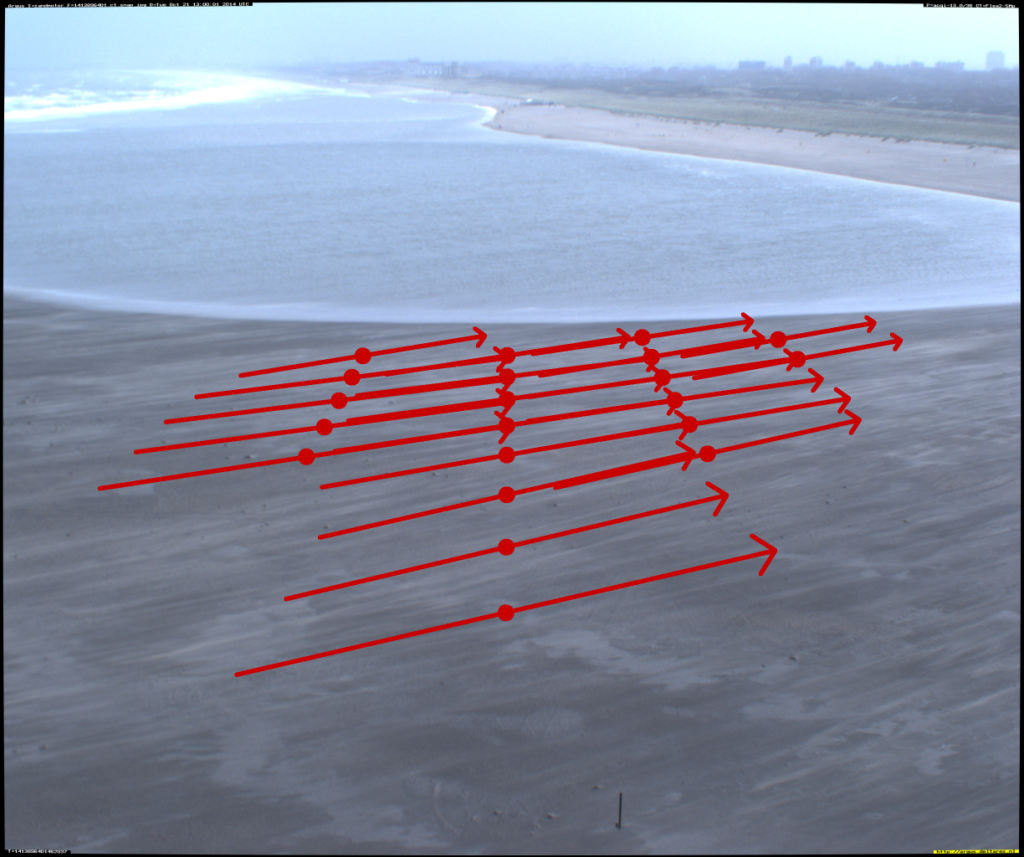Dune formation
Coastal dunes are essential for providing coastal safety and have a natural capacity to keep up with sea-level rise by accumulating and stabilizing wind-blown sand. Dune growth, and their recovery after storm erosion, requires the supply of sediment from the beach, which is driven by the wind. To be able to accurately assess the dune and its ability to protect against flooding, this supply needs to be understood. The first objective was to observe and understand aeolian transports towards the dunes, while the second objective was to study the effects of vegetation on dune development.
Observations of aeolian transport
by Isaac Williams
The growth of dunes requires the supply of sediment from the subaerial beach by wind-driven, or aeolian, processes. These processes are utilized at the Sand Motor to ensure that the dunes offer the desired level of protection against coastal flooding. Studies suggest that a few large-scale transport events may be responsible for a majority of the sediment supply towards the dunes at monthly to annual timescales. However, predicting longer term sediment supply remains highly uncertain, with controlling parameters poorly constrained. In part, this is due to the lack of datasets extending over the requisite timescales and with sufficient temporal resolution to resolve individual transport events. To this end, video images provide a useful tool.
Large-scale transport events are often characterized by the presence elongate regions of intense transport which are orientated parallel to the mean wind direction and are visually identifiable in images. Consequently, the identification of these features, which are termed streamers, may be pertinent in the evaluation of longer-term transport rates. The Sand Motor is surveyed during daylight hours by the Argus camera station. The station consists of 12 cameras providing a 360 degree view of the beach. Since 2011, the cameras have been producing a number of image products at half hourly intervals. These images have the ability to provide insight into aeolian transport processes at the Sand Motor.

A methodology has been to developed which seeks to identify the occurrence of large scale transport events in images in an automated manner. Traditionally this has been done manually and is consequently time consuming and subject to the introduction of user bias. Spectral analysis is employed to find the dominant orientation of image features about within an image. During significant transport events, the orientation of the determined image features cluster about the mean-wind direction at the time that the respective image was taken.
This is consistent with the presence of streamers. In contrast, in the absence of transport the method fails to identify an orientation. Preliminary testing indicates that the method is adequate in identifying whether or not transport is occurring within a given image. The method has also been applied to examine the occurrence of large scale transport events, at a fine temporal resolution but over annual timescales.

Contribution of vegetation of dune development
by Corjan Nolet
The stabilization of wind-blown sand in the Dutch dunes is attributed to the specialized morphology of marram grass (Ammophila arenaria). This coastal grass species combines two unique advantages for dune-building, namely (1) very high tolerance to burial by wind-blown sand, and (2) more vigorous growth under the right conditions of sand burial. This introduces a positive feedback essential to dune development: adequate levels of wind-blown sand encourage marram grass to grow, which in turn enhances its capacity to accumulate and stabilize wind-blown sand. Results from empirical research on the dunes adjacent to the Sand Motor indicate an optimal burial rate for marram grass around 0.31m of sand per growing season, and suggest a maximum burial tolerance between 0.78m and 0.96m of sand per growing season.
These findings are advantageous to coastal safety in the Netherlands: in order to maximize natural dune development, coastal (mega)-nourishment strategies can aim for input of wind-blown sand towards the dunes (or other deposition zones) around the optimal burial rate for marram grass during the growing season and not exceed its maximum tolerance. Along the Sand Motor, while average accretion rates vary, the front of the foredune has consistently received sand around the optimal burial rate for marram grass to thrive under. Over the last three years, though, the maximum observed burial rates are about twice as less than the maximum burial tolerance for marram grass. This suggests that the rate of (fore)dune development could be higher still than is currently observed.
This study aimed at predicting coastal dune development by incorporating positive feedback are hampered by an inadequate description of growth response of marram to sand burial.
At the start of this research some people having concerns about swimmer safety or nuisance from blowing sand for example, but public opinion has changed since into a very positive perception.
People now really enjoy the wide open space and varied landscape that the Sand Motor provides, as well as other opportunities such as kitesurfing or hunting for fossils. So in terms of recreational purposes the Sand Motor is seen as a great success.

More information on these topics can be found in this book.
